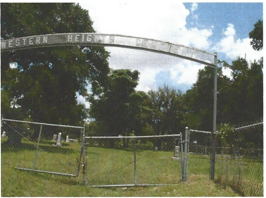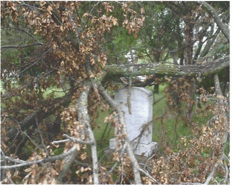By Frances James (1922 – 2019)

The Western Heights Cemetery in the 1600 block of Fort Worth Avenue is about three and one-half miles west of the Dallas County Courthouse. The three acre cemetery is on a portion of the William Coombs 640 acre Survey Number 290. This cemetery was on the trail heading west and it is believed that several strangers who died along the way were buried here in the 1840-1860s. The earliest records for this community cemetery state that the first burial was of seventy-eight year old Augustine Byrum on June 27. 1848. He is in an unmarked grave. This was many years before this land was finally declared a cemetery in a deed dated 1881. This person is one of those,”known only to God” in our world. He died before 1850 and Byrum does not show up anywhere in the United States census for 1840. A source for this information has not been found.
The William Coombs Survey No. 290, today, would be bounded by Vilbig St. on the west, Singleton Blvd. on the north, Cedar Hill Ave. on the east, and a portion south of Ft. Worth Avenue. This area was first called Hord’s Ridge and re-named Western Heights in 1901. William Hord who had come to the Three Forks area in 1845 and settled on land west of the Trinity River was a brother-in-law of John Crockett, one of the first attorneys in Dallas County, who later became Lieutenant Governor of Texas during the Civil War.
Kentucky native forty-three year old William Coombs his wife, Ivy Green Coombs (1805-1847) and his three sons, Isaac (20) and Levan (22) and William, Jr. (18) immigrated to Texas in 1843 and all were eligible for, and received Peters Colony certificates for land. William had not been here long before his wife, the mother of the three sons, died in childbirth.
By 1850 widower, forty-seven year old William Coombs, married a widow, Rachel, who had two daughters. Their baby, Martha, was born in 1850 and the Coombs lived on their large farm west of the Trinity River.
La Reunion Colony purchased part of Levan Coombs’s survey for its village in 1855. Flanders Heights, one of the first planned additions for homes in this farming community was designed and built adjacent to this cemetery on its western side in 1884.
The Coombs Survey had been divided and sold in various portions through the years and the cemetery was part of a forty-two acre tract that B.M. Bradford (1815-18??) had purchased. He sold three acres in 1881 to Zachariah Coombs (1837-1917) and W.R. Fisher (1836-1900) for $15.00 that would allow the land to be used for a church and a “graveyard” forever.
Mr. Fisher was a grocer in West Dallas and his wife was Mary Ann Coombs, the daughter of J. N. Coombs. Pennsylvania native W.R. Fisher was one of sixteen children who learned the cabinet making trade when he was fourteen. He supported himself by working in Kentucky as a carpenter until the Civil War when he went to Virginia and enlisted in the Forty-Fifth Virginia Battery. At the second battle of Winchester, Virginia he was taken prisoner and confined in a Delaware prison for nine months, and three months after General Robert E. Lee surrendered. He worked on the Virginia and Tennessee railroad repairing bridges and building section houses until 1867 when he came to Texas. He worked for a year in Houston and came to the Dallas area purchasing seventy acres of the old Coombs homestead. He and Mary Ann were married in 1869. She died in 1873.
There has never been a church built on this property. Bradford and Coombs were elders of the West Dallas Christian Church in the 1880s, which was built several blocks away from the cemetery. Both Mr. and Mrs. W. R. Fisher were members of the Church of Christ.
In 1856 twenty year old John Loupot, arrived in Dallas County with fifteen cents in his pocket. He came from France to join the La Reunion Colony. He first found work herding sheep then farmed with the Colony for one year. He went to Kaufman County and worked on a farm for a few months and returned to Dallas to work for an uncle on his farm. John spent four years during the Civil War in Mexico freighting cotton. After he came back to Dallas he married Swiss native Rosina Getzer in 1869. He and Rosina had five children. Loupot was also a mason, having learned that trade from his father in France. He was responsible for constructing many early brick buildings in Dallas. By 1875 the Loupots owned a 160 acre farm west of the Trinity where they specialized in gardening and dairying. French native John (Jean) Loupot (1835-1904) and his wife, Rosina, who also came to Texas as a La Reunion colonist are buried in Western Heights Cemetery.
Widower Zachariah Ellis Coombs, son of William Coombs Jr., married Rebecca F. Bedford. On the Zachariah Coombs headstone in the Western Heights Cemetery, it states that he was a Captain in the 31st Texas Cavalry, Co. G, CSA, also a Mason and was Grand Master of Masons in Texas from December 1885 to December 1886.
The wording on a marker does not tell the complete story of this early settler in Dallas County. Coombs was elected County Judge in 1866. He was among the four hundred officers in fifty seven counties who were removed for failure to comply with the amnesty oath by the military commandants sent to Texas during the Reconstruction Period.
Coombs was an alderman for the City of Dallas in 1868-1872. He was again affected by this same upheaval following the Civil War. He and R. S. Kimbrough were State representatives in Austin in 1886. Zachariah was an original member of the Dallas County Pioneers when it was organized in 1875. In 1913, a clipping in the Dallas Morning News noted that the Hardin School (located on the corner of Main and Haskell) would hold its third commencement, and that Zachariah Coombs was a member of the Sigma Phi Society who would deliver a declamation.
One of the first female babies born in Dallas County in 1845, a granddaughter of Dr. John Cole, Mary Ellen Cole Tuggle (1845-1928), is buried in this cemetery as is her husband, William Thomas Tuggle (1843-1925) a Confederate veteran from Missouri. Who served in Walker’s Division and Young’s regiment. Their sons, daughter and several grandchildren are also buried nearby.
In 1922 Mrs. Anna Marie Struck (1854-1923) purchased one-half acre in the cemetery and dedicated it as a memorial family plot to honor her husband, Heinrich Frederich Struck (1856-1917) from Mecklenberg, Germany. Their son Henry Carl Struck, who served in the United States Army in World War I is buried here also.
Many of the over 400 known burials in Western Heights were the pioneers of Hord’s Ridge, later the town of Oak Cliff. Dallas annexed Oak Cliff in 1903 after several attempts to persuade the citizens that it would be better for them and for the children because of the expense of maintaining enough schools. Many citizens were skeptical because of the sale of liquor. The area is still dry! Only Special Use Permits allow the sale of liquor.

It is believed that the Church of Christ was first established in Dallas in 1852. A shortage of ministers to serve the vast sparsely settled area caused the church to organize a county cooperative to reach out to the people by 1856. The Pearl and Bryan Street Church with fifteen members (unable to substantiate) was described in the early history of the church written by Melvin Wise. These few members were concerned about the families west of the Trinity River and initiated missionary efforts across the river. The Pearl and Bryan Street Church invited General R. N. Gano to hold a revival in the old Mt. Airy schoolhouse in Oak Cliff in 1872. Although meeting at the schoolhouse and other locations, this is thought to be the first Church of Christ in Oak Cliff.
General Gano, a licensed medical doctor, was a remarkable man. He gave up medicine to join the Confederacy and fought in over 70 battles during the Civil War as a cavalry officer and five horses were shot under him. He was wounded only once. After the war he settled in Dallas County, owning land where the Dallas Ft. Worth International Airport is located. He became an ordained minister, raised thoroughbred horses, and surveyed previously uncharted portions of North Texas. In his daily journal, the general once wrote: “Today I surveyed 16 sections and saved 16 souls.” In the 1875 City Directory on page 18, he is listed as R. M. Gano, elder, being the pastor of the Christian Church. General Gano is buried in Oakland cemetery with many members of his large family.
The Christian Church and the Church of Christ divided over the use of musical instruments in the church during this time period.

It is not known if there has ever been an organization to maintain this cemetery. Through the last 100 years the various Christian Churches and Churches of Christ have united, dissolved, left the city, moved to the other side of the county, and sold their properties to each other, but through the years the Western Heights Cemetery has been maintained by volunteers. In the 1980s a fund was started to erect a fence around the property. When enough money was donated a fence was erected. Vandals have managed to cut it in several places, when the gates are locked. These desperate people are most interested in viewing the grave site of Clyde Barrow (1909-1934). Various tokens appear on his concrete embedded headstone. The headstone had been stolen and removed several times before the city crews returned it and finally set it in concrete to make its removal more difficult.
Through the years members of one of the churches would have a clean up day at the Western Heights Cemetery. From time to time Boy Scouts would be enlisted to help. Nearly twenty years ago a retired City of Dallas fireman and his wife, Steve and Opal Perry, decided they would personally maintain the cemetery as they had family members buried there. Using their own equipment, they did the work, hauled off the trash, cut back the vines, and wrote letters to known descendants asking for donations to establish a fund for the future. When their health no longer permitted this massive volunteer work to continue other means have been adopted.
Crews have been hired to mow the straggly grass and cut back the vines along the fence. One of the counselors at the Texas Youth Commission has used volunteers from its unlimited supply of manpower to maintain the site. These boys, assigned community service hours by the judges, receive no pay for their labor, but lunch is provided and equipment and material (gas for mowers, etc.) is provided from their own donated fund. When the local neighbors with no respect for this hallowed ground, dump their trash on the site, extra money has to be spent from the small fund to clean up the site.
In April and May of 2007 wind storms and heavy rain hit this section of town and many of the old trees were uprooted. Crews were hired to remove the trees and some of the headstones were damaged. Vast amounts of debris were piled outside the fence for the City of Dallas Sanitation Department to remove.
A Texas Historical Marker facing Fort Worth Avenue denotes the importance of this historical site.

Frances James, “Dallas County History – From the Ground Up, Book I,” 2007.


